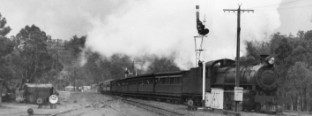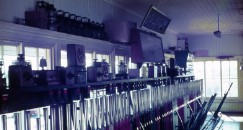This entry was to be repeated in the 1922 General Appendix with the slight variation advising that the signal box is "switched in between certain hours (See current time table") and when required”. Strangely, it was never cancelled during the 42 year currency of that Appendix. Despite the hopeful prognostications of the 1922 General Appendix, events were to show that Summers Street was never to lose its status as a block post opened as and when required. None of the WAGR Working Timetables published up to the time of its demise record any regular opening times for the cabin, indicating that its opening s were very much an unusual occurrence.
Summers Street was located 30 chains from East Perth, and was roughly half way between East Perth and Mount Lawley. Its provision reduced the headway of trains between East Perth and Mount Lawley, however, precisely why the WAGR administration considered this a consideration as important as to justify establishing a box that was to be seldom used is not now apparent. There was nothing particularly unusual about the section between Mount Lawley and East Perth, such as heavy grades or tight curves, that reduced track speed making it beneficial for train working to divide the section. Indeed, if that was the consideration then it would have been more logical to place a block post between Maylands and Mount Lawley on account of the heavy climb Up and Down trains faced running between those two stations. Nor was there any contemporaneous attempt to reduce headways on the Eastern Railway generally through opening of additional block posts. The answer might be found by looking at the section between Perth and East Perth. By that stage this section was probably the busiest on the entire WAGR network, being traversed by all through trains running on the Eastern and South West Railways. Increasing the capacity of the track between East Perth and Mount Lawley through the introduction of a shorter section East Perth- Summers Street enabled East Perth to dispatch Eastern Railway trains more efficiently, thus effectively increasing line capacity. However, why the Railway’s administration felt that it could only take advantage of this opportunity on an "as required" , basis, rather than regularly during, for example, normal peak periods, is not known. Perhaps the administration was anticipating a boom in traffic that would justify the opening of the cabin on a more regular basis. Unfortunately, as events were to transpire that boom never eventuated.
Summers Street worked with East Perth to the South West and Mount Lawley to the North East. Absolute double line block working was in force on both mains. Distant and Home Signals were provided for both mains, the Home signals acting as the Starting signals. The Up Home post also accommodated East Perth’s Up Distant while the Down Home post accommodated Mount Lawley’s Distant signal. No passenger facilities were provided, rendering it one of the few metropolitan block posts with no platform or like accruements. However, despite the lack of such facilities Summers Street did see a regular passenger service. In July 1921, number 574 passenger (a late evening Up train) was timetabled to stop at the cabin, presumably to allow staff from East Perth Loco to board or alight. This rendered the cabin unique: As far as the author has been able to determine no other metropolitan block post without dedicated passenger facilities was ever used as a passenger stopping place. For how long this practice continued is the subject of future research.
The Cabin was probably a standard WAGR weatherboard pitched roof cabin. Apart a few skillion roofed monstrosities that dated back to the C. Y. O' Connor era (the great engineer imported a number of New Zealand building designs of unrelieved ugliness) ,the standard pattern pre-1960 WAGR signal cabin conformed to a pleasantly proportioned weatherboard pitched roof design, and the law of averages suggests that Summers Street was probably a small example of that genre, which due to wartime shortages, may have been recycled from another location. If it was in fact a relocated cabin the possibility exists that it was in fact a skillion roofed cabin which might suggest that aesthetics required the purge of all relevant records from the WAGR archives! Unlike other small cabins in other parts of the network, where the frame was outside, we can be sure that Summers Street's 10-lever frame was well and truly ensconced in the cabin: Safeworking Block instruments were not weatherproof they had to be safely under cover at all times.
It would seem that the occasions for which the cabin was designed to accommodate were to be infrequent, and as time wore on the infrequency (as the Irishman said) increasingly decreased. The Weekly Notices record the cabin as being opened mostly on Public holidays, for Race meeting traffic and during the Christmas and Easter holidays, between about four and ten times a year until the end of 1927. Thereafter the frequency rapidly declined. It is possible that the cabin may have seen more use than the remaining records attest (for absence of evidence is not evidence of absence) however, these were unlikely to have been of any great import.
When the signal porter switched out the cabin and returned the key to the East Perth Station master on 7 October 1929, he probably did not know that he was closing the cabin for what was almost certainly the second last time. A few weeks after the Station master took possession of the key, the infamous Wall Street crash would occur, heralding the onset of the Great Depression, which would see the cabin's fortunes sink even further than that which it had endured in the late 1920s.
The Depression struck Australia with particular savagery. Unemployment hit lethal levels, and those who were fortunate to retain a job suffered significant financial stress. Train travel became a luxury that many could not afford, and passenger numbers declined precipitously, reaching a nadir in 1932. With traffic at such low levels, there was hardly a need for the Summers Street cabin: Indeed, during the last three years of its life it was officially opened only once, this being in October 1931. Summers Street had become a white elephant, a cabin whose existence was predicated on need to facilitate workings which no longer existed.
Whether the cabin would have been closed and removed as was the case with other redundant locations is impossible to say, as the Signalling Record Card for the box shows that the upper portion of the box burnt down on at approximately 5:00 p.m. on the 19th of December 1932, ironically around the time it would have been open had the early to mid 1920s traffic patterns continued. The incident seems to have escaped the attention of the local press, and was never mentioned in the Weekly Notices or the Annual Reports. Had the cabin never been destroyed it is unlikely it would have survived. Once it was gone, the WAGR never considered it necessary to reinstate the cabin: not even when the Second World War stretched the system to the limits when such a cabin would have, one would have thought, been most needed. The WAGR probably realized that the cabin was not really necessary, and no doubt was thankful for fate removing it.
Many years later the site was levelled and regraded into a car park for the WAGR (later Westrail, now PTA) Headquarters, this process ultimately destroying all trace of East Perth Loco. The cabin that had never lived up to expectations simply because those expectations were never fulfilled, has vanished without physical trace, leaving only scattered records as its legacy.


